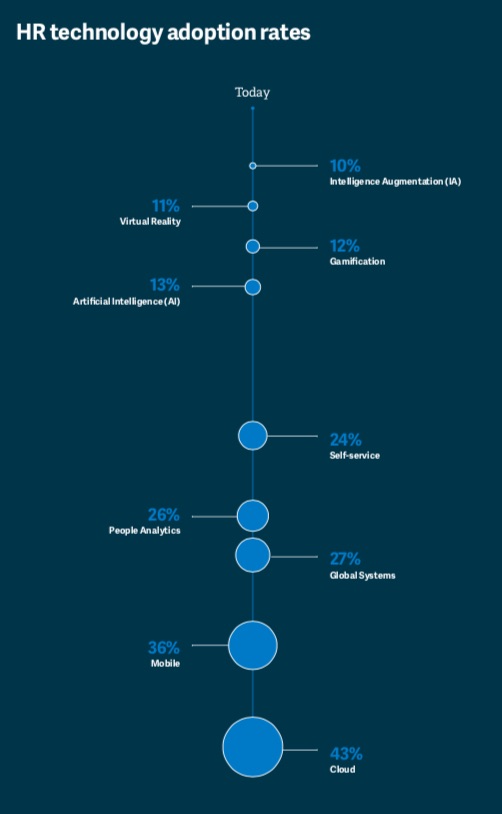Human Resources (HR), as a department and function, is changing as we know it. Today, no longer are HR and People teams siloed to payroll and insurance.
While those in the sector are certainly aware of the change that’s rapidly occurring, even those in other departments are beginning to understand the widening impact of HR’s role in companies.
HR is quietly transforming to a “People” function. Just as Personnel evolved into HR in the 1980s, it’s now shifting away from process and administration, toward delivering more high-value strategic initiatives across organizations—as more and more companies wake up to the fact that there’s a war for talent raging across sectors, and to be the best, you must attract and retain the best.
Unrecognizable in 10 Years’ Time
As a result, and according to a Sage report, 82 percent of HR and People leaders anticipate that the role of the HR director will be completely unrecognizable in 10 years’ time.
That’s no surprise. We know organizations are having to work harder to not only attract, but keep, top talent. Fast-growth progressive companies that want to get ahead know the value of putting people at the top of the business agenda. As such, more is expected from leaders of HR teams, particularly as they move from being traditionally seen as a backroom function to a boardroom function, consistently offering more strategic value and contributing to business growth.
An Internal Skills Gap
However, there is a skills gap even among HR executives, with 86 percent of HR executives in Sage’s report having noted a need to reskill in this new changing world of work—which naturally creates an impasse between their current role and the new expectations of HR. These new expectations include skills involving analytics, behavioral sciences, communications, and technology aptitude.
Combine this with new, increasingly complex compliance regulation in HR; new workstyles, such as the growth of the contingent workforce and gig economy; the varying expectations of a multi-generational workforce; stubbornly low productivity and engagement; and the emergence of new digital technology in both the workforce and HR, and it’s no surprise there’s huge pressure on HR leaders to call on a wider range of skills as they respond in these new emerging roles.
Interestingly—and worryingly—the top skills HR directors identified as important in the coming years were also the areas where they feel they have the biggest gaps: tech-savviness, creativity, and people analytics.

Slow to Adopt (but Getting There!)
But there is good news: While many are slow to adopt new technologies that could aid productivity and growth, a good percentage of businesses is testing the waters. Sage found that while only 24 percent of businesses are using artificial intelligence (AI) for recruitment currently, that number likely will double in the next 12 months, as 56 percent plan to adopt it within the next year.
Furthermore, becoming tech-savvy with technologies such as automation, analytics, and cloud enables HR to work smarter, faster and more strategically, further encouraging the transition from being process-focused to people-focused.
Automation, analytics, and cloud technologies mean up-to-the-minute business reports can be generated at the touch of a button. In addition, automation helps eliminate the likelihood of human error. Most of all, the best tech frees up HR and People leaders’ time to concentrate on what’s truly important: delivering great workforce experiences for their people.
With 43 percent of HR leaders believing their organization will not keep up with changes in technology over the next 10 years, however, there’s still a lot to do.
The Journey Toward a more People-Focused Organization
As HR teams transition away from processes and toward more people-focused strategies, there are two huge things they can do to get ahead.
1. Address the HR skills gaps immediately. Chief Human Resource Officers (CHROs) can’t—and shouldn’t—be experts in everything. Alongside upskilling existing HR experts in new People-focused and technological roles, Sage research revealed companies also have acknowledged that they must diversify and source skills needed from non-conventional routes in HR. In fact, 34 percent said they plan to hire non-traditional HR profiles.
2. Make the business case. Some 53 percent of HR and People leaders noted they can’t make the business case for change—but it’s non-negotiable for the success of a business. Building a robust and comprehensive business case is a powerful tool to get that all-important slice of budget for HR, and, in turn, build HR capability and impact.
Ultimately, expectations of HR leaders are evolving, but not just across the business world. Some 69 percent of HR leaders polled said they believe employee expectations of HR are changing, too. In today’s changing world of work, people want to be part of an organization they believe in and that creates great workforce experiences for them. To do that, a company needs to know this right at the top—and that’s where HR comes in.
Paul Burrin is a work trends expert; a “People geek”; and vice president at Sage People, a global cloud HR and People platform that helps organizations around the world acquire, retain, manage, and engage their workforce. Burrin is an expert on the intersection of marketing, HR and technology, and is an active author, contributor, panelist, and speaker on the changing nature of work, the workplace, workstyles, and the rise of the modern workforce.




